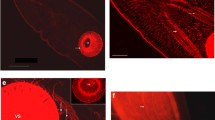Abstract
Previously by immunohistochemical technique the distribution of immunophilin 1–15 fragment (IphF) isolated from bovine hypothalamus was examined in various tissues (heart, lung), including immune system organs (spleen and thymus) of intact rats. IphF-like immunoreactivity (IphF-LI) was revealed in several cell types: lymphocytes, monocytes, macrophages and mast cells. In the present study the immunohistochemical localization of IphF was examined in intact rat and frog brains. In rat brain several cell groups concentrated particularly in the supraoptic nucleus (SON) of hypothalamus, medulla oblongata (reticular formation, olives, hypoglossal and facial motor nuclei) and cerebellum (lateral cerebellar nucleus) demonstrated IphF-LI. In frog hypothalamus (SON) the same working dilution (1:5000) of IphF-antiserum revealed very strong immunoreactivity. In the paraventricular nucleus (PVN) IphF-LI varicosities were scattered around the immunonegative cells. The second cell groups showing IphF-LI in the frog brain were gliocytes (mainly the astrocytes). Besides, IphF distribution was investigated in rats subjected to hemisection of spinal cord (SC) with and without administration of proline-rich polypeptide (PRP). PRP was isolated from bovine neurohypophysis neurosecretory granules, produced by magnocellular nuclei of hypothalamus. Hemisection of SC led to changes of IphF distribution in the hypothalamus. In PRP treated animals IphF showed no immunoreactivity. PRP is suggested to act as a neurotransmitter and neuroregulator.
Similar content being viewed by others
REFERENCES
Galoyan, A. A. and Gurvits, B. Ya. 1992. Discovery of peptidyl-cis-trans-isomerase in the hypothalamus (its new functions). Neurochemistry (issue of RAN and NAS RA), 11:89–91.
Gurvits, B. Ya. and Galoyan, A. A. 1993. Isolation of cyclophillin, a receptor of immunodepressant FK-506, from bovine hypothalamus. Abstract of the 14-the ISN Meeting, Montpellier, LA2-D.
Galoyan, A. A. 1997. Biochemistry of Novel Cardioactive Hormones and Immunomodulators of the Functional System Neurosecretory Hypothalamus-Endocrine Heart, 242 P. Nauka Publishers, Moscow.
Hsu, S. M., Roine L., and Farger H. 1981 Use of avidin-biotinperoxidase complex (ABC) in immunoperoxidase techniquies: a comparison between ABC and unlabelled antibody (PAP) procedures. J. Histochem. Cytochem. 29:577–580.
Gu., J., Islam, K. N., and Polak, J. M. 1983. Repeated application of first layer antiserum improves immunofluorence staining procedure. Histochemistry 15:475.
Ambrosius, X. 1987. Obtaining of antisera from different animals. Pages 14–15, in H. G. Frimel (ed.) Immunological methods.
Bret-Dibat, J. L., Zouaoui, D., Dery, O., Zerari F., Grassi, J., Maillet, S., Conrath, M., and Couraud, J. Y. 1994. Antipeptide polyclonal antibodies that recognize a substance P-binding site in mammalian tissues: a biochemical and immunocytochemical study. J. Neurochem. 63:333–343.
Landberg, J. M. and Hökfeld, T. 1983. Coexistence of peptides and classical neurotransmitters. TINS 325.
Eskay, R. L., Furness, J. B. and Long, R. T. 1981. Substance P activity in bullfrog retina; localization and identification in several vertebrate species. Science 212:1049–1051.
Compbell, G., Gibbins, I. L., Morris, J. L., Furness, J. B., Costa, M., Olivier, J. R., Beardsley, A. M. and Murphy, R. 1982. Somatostatin is contained in and released from cholinergic nerves in the heart of the toad Bufo Marinus. Neuroscience 7:2012.
Galoyan, A. A., Kipriyan, T. K., Sarkissian, J. S., Sarkissian, E. J., Grigorian, Y. Kh., Andreasian, A. S., and Chavushian, V. A. 2000. The protection of snake venom (Vipera Raddei Boettger 1898) neuronal injury by the new hypothalamic neurohormone. Neurochem. Res. 25:791–800.
Galoyan, A. A., Sarkissian, J. S., Kipriyan, T. K., Sarkissian, E. J., Grigorian, Y. Kh., Sulkhanyan, R. M., and Khachatrian, T. S. 2000. Comparison of the Protection against Neuronal Injury by Hypothalamic Peptides and by Dexamethasone. Neurochem. Res. 25:1567–1578.
Author information
Authors and Affiliations
Rights and permissions
About this article
Cite this article
Abrahamyan, S.S., Meliksetyan, I.B., Sulkhanyan, R.M. et al. Immunohistochemical Study of Immunophilin 1–15 Fragment in Intact Frog Brain, and in the Brain and Spinal Cord of Intact and Spinal Cord Hemisectioned Rats. Neurochem Res 26, 1225–1230 (2001). https://doi.org/10.1023/A:1013915306403
Issue Date:
DOI: https://doi.org/10.1023/A:1013915306403




